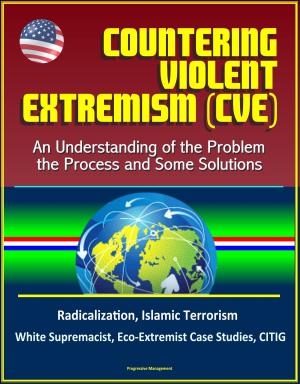Pearl to V-J Day: World War II in the Pacific - Air Force Symposium, Grand Strategy, Island Campaign, Intelligence Methodologies, Sea War Against Japan, Air and Submarine War, Atomic Bomb Decision
Nonfiction, History, Military, Aviation, World War II| Author: | Progressive Management | ISBN: | 9781310618284 |
| Publisher: | Progressive Management | Publication: | August 1, 2015 |
| Imprint: | Smashwords Edition | Language: | English |
| Author: | Progressive Management |
| ISBN: | 9781310618284 |
| Publisher: | Progressive Management |
| Publication: | August 1, 2015 |
| Imprint: | Smashwords Edition |
| Language: | English |
Professionally converted for accurate flowing-text e-book format reproduction, this Air Force publication records the proceedings of an Air Force symposium which offered a unique opportunity for its guest panelists—participants in that war or historians of it—to reflect on a variety of subjects: Japanese objectives; American military preparedness and grand strategy; the interaction between U.S. Army, Air, and Navy leaders; combined operations; political and diplomatic intrigue; the challenges of ground, air, and sea warfare within differing Pacific theaters; military science and technology; the essential role of intelligence; the proposed Allied invasion of the Japanese home islands; and the use of the atomic bombs.
For the United States, World War II began and ended in the Pacific, from Japan's aerial attack on Pearl Harbor, on December 7, 1941, to its surrender in Tokyo Bay, on September 2, 1945. During those years, for all but five months, Americans and their Allies were compelled to hold the line in Asia, doggedly opposing the imperialist Japan while a "Europe First" policy against Nazi Germany and fascist Italy prevailed in the Atlantic and the Mediterranean. The United States operated over huge distances, from China, Burma, and India, to countless Pacific islands from the Aleutians to the Coral Sea. It sent its Army, Navy, Marine, and Air forces into grueling and horrific battles against a Japan bent at all costs on expanding its empire across thousands of miles and exploiting human and natural resources wherever it conquered.
The momentous Allied victory in World War II made the United States the superpower it has been for half a century and, in large measure, determined its military planning into the present day. The War in the Pacific in particular proved that American military personnel fought bravely in many climes, on many fronts, against the odds, with amazing ingenuity and purpose. The discussions on World War II in general and the War in the Pacific in particular presented herein deal frankly with a time that tested America's resolve as it was never tested before and has not been tested since.
Grand Strategy in the Pacific War * Gerhard L. Weinberg * Joint Operations * Walter S. Poole * The Island Campaign * Brig. Gen. Edwin H. Simmons, USMC (Ret.) * Intelligence Methodologies in the Pacific War * John Prados * The Sea War against Japan * William S. Dudley * Military Technology and the Pacific War * Richard P. Hallion * Strategic Intelligence and War Termination * Edward J. Drea * Revolutionizing Submarine Warfare * Rear Adm. Eugene B. Fluckey, USN (Ret.) * The Strategic Air War against Japan * William M. Leary * The Decision to Drop the Atomic Bomb * Theodore H. McNelly
Professionally converted for accurate flowing-text e-book format reproduction, this Air Force publication records the proceedings of an Air Force symposium which offered a unique opportunity for its guest panelists—participants in that war or historians of it—to reflect on a variety of subjects: Japanese objectives; American military preparedness and grand strategy; the interaction between U.S. Army, Air, and Navy leaders; combined operations; political and diplomatic intrigue; the challenges of ground, air, and sea warfare within differing Pacific theaters; military science and technology; the essential role of intelligence; the proposed Allied invasion of the Japanese home islands; and the use of the atomic bombs.
For the United States, World War II began and ended in the Pacific, from Japan's aerial attack on Pearl Harbor, on December 7, 1941, to its surrender in Tokyo Bay, on September 2, 1945. During those years, for all but five months, Americans and their Allies were compelled to hold the line in Asia, doggedly opposing the imperialist Japan while a "Europe First" policy against Nazi Germany and fascist Italy prevailed in the Atlantic and the Mediterranean. The United States operated over huge distances, from China, Burma, and India, to countless Pacific islands from the Aleutians to the Coral Sea. It sent its Army, Navy, Marine, and Air forces into grueling and horrific battles against a Japan bent at all costs on expanding its empire across thousands of miles and exploiting human and natural resources wherever it conquered.
The momentous Allied victory in World War II made the United States the superpower it has been for half a century and, in large measure, determined its military planning into the present day. The War in the Pacific in particular proved that American military personnel fought bravely in many climes, on many fronts, against the odds, with amazing ingenuity and purpose. The discussions on World War II in general and the War in the Pacific in particular presented herein deal frankly with a time that tested America's resolve as it was never tested before and has not been tested since.
Grand Strategy in the Pacific War * Gerhard L. Weinberg * Joint Operations * Walter S. Poole * The Island Campaign * Brig. Gen. Edwin H. Simmons, USMC (Ret.) * Intelligence Methodologies in the Pacific War * John Prados * The Sea War against Japan * William S. Dudley * Military Technology and the Pacific War * Richard P. Hallion * Strategic Intelligence and War Termination * Edward J. Drea * Revolutionizing Submarine Warfare * Rear Adm. Eugene B. Fluckey, USN (Ret.) * The Strategic Air War against Japan * William M. Leary * The Decision to Drop the Atomic Bomb * Theodore H. McNelly















